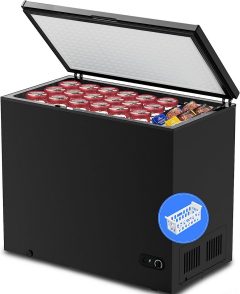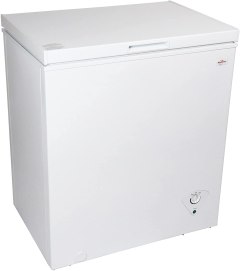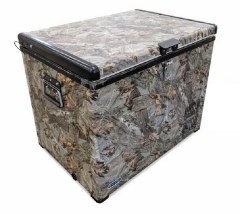Buying guide for Best chest freezers
It’s easy for your refrigerator’s freezer to get filled up, whether you like stocking up on sale meats or preparing casseroles for a rainy day. For those who’d like a little more freezer space, a chest freezer is an ideal solution.
A chest freezer is a freestanding freezer with an open design that usually holds more food per square foot than an upright model. Its door is attached along the back edge of the chest and opens vertically. Because of the design, cold air doesn’t escape as easily when the door is opened, so items inside stay as cold as possible.
With so many chest freezers to choose from, it’s important to find the right one for your needs. You have to decide on the best size, whether you want a manual or auto-defrost model, how important an adjustable thermostat is to you, and what other features would make your life easier.
Key considerations
What size do you need?
Chest freezers are available in four general sizes: compact, small, medium, and large.
Compact models generally offer five cubic feet of storage space, while small chest freezers usually have a capacity of six to nine cubic feet. Moving up in size, medium chest freezers typically have 12 to 18 cubic feet of storage space, while large models have a capacity of more than 18 cubic feet.
In most cases, you should multiply the number of people in your household by 1.5 cubic feet to determine how much freezer space you need. For example, a family of four should opt for a chest freezer with at least six cubic feet of storage.
Do you want manual or auto-defrost?
Over time, a chest freezer can develop ice build-up that affects its energy efficiency. In some cases, the frost may even prevent the freezer from closing fully.
Some chest freezers must be manually defrosted. This involves removing all food, turning off the freezer, waiting for the ice to melt, and cleaning the interior before refilling it. In the meantime, you have to find another place to store your frozen food.
If you purchase a freezer with an auto-defrost feature, you don’t have to go through that manual process. These freezers don’t develop ice because they automatically defrost approximately once per day. During the automatic defrost cycle, the freezer’s internal temperature adjusts by about 2°F. Your food should not be affected by this minimal amount.
The downside to chest freezers with auto-defrost is that they’re pricier, noisier, and more likely to cause freezer burn.
Do you need an adjustable thermostat?
A chest freezer with basic temperature controls can be set to “low” or “high” (or similar) rather than a precise temperature. This could be an issue if you need to keep the freezer at a specific temperature. If you do, consider one with an adjustable thermostat and dial controls. The settings are typically numbered, such as 1, 2, 3, 4, and 5. Some chest freezers may have up to seven temperature settings for precise temperature control.
Expert Tip
Because frost can eventually obscure a storage container’s contents, label each item you put in the freezer. I use masking tape and write the item name, how much of it is in the container, and the date when it was originally frozen.
BestReviews Cooking and Baking Expert
Features
Baskets, shelves, and dividers
Because chest freezers have an open design, most include organization tools to help you optimize storage space. Some include hanging baskets that hold food; others feature adjustable shelves. Some chest freezers have simple plastic dividers that you place at the bottom of the chest to separate your food.
A chest freezer that includes baskets, shelves, or dividers is easier to use than one without any type of organization. If your food is just piled inside the freezer without any organization, you’ll constantly have to move items around when you’re trying to find what you’re looking for.
Power lights
It’s important to know that your chest freezer is working, or you run the risk of the food inside spoiling. A model with power-on lights allows you to see that the freezer is working just by looking at its front panel, so there’s no need to open the freezer to check.
Temperature alarm
Depending on what you store in your chest freezer and how frequently you remove food from it, you may not necessarily know if the temperature begins to rise to unsafe levels — unless, that is, you have a model with a temperature alarm. This feature continuously monitors the internal temperature of the freezer and sounds an audible alert if the temperature rises too high.
Expert Tip
Freezer burn is a condition that’s caused by air getting to the food within the freezer and dehydrating it. You can avoid freezer burn by ensuring all your food is in airtight packaging.
BestReviews Cooking and Baking Expert
Interior light
Because chest freezers can be fairly deep, it may be difficult to see all the way inside. A freezer with an interior light is much easier to inspect, particularly if you’re looking through it at night.
Defrost drain
If you opt for a manual defrost chest freezer, choose one with a defrost drain. That way, when you defrost the freezer, you can simply open a drain to release the water. Most chest freezers also include a hose adapter, so you can connect a hose to drain the water to a more convenient location.
Freezer lock
If you have small children, a chest freezer presents a possible danger because a child may be able to open the freezer and fall inside, becoming trapped. Some chest freezers have locks that allow you to prevent access. For many parents, the peace of mind that a lock offers is worth the additional expense.
Caution
If the temperature of your chest freezer rises above 40°F for more than two hours, the food inside will not be safe to eat. Unfortunately, it should be thrown away.
STAFF
BestReviews
Chest freezer prices
Chest freezers vary in price based on size and features. You could pay under $200 or over $4,000 for one. Let’s take a look at some general sizes and price ranges.
Small chest freezers
The most affordable chest freezers are compact models that have a capacity of five cubic feet or less. They usually cost between $165 and $350. Small chest freezers with a capacity of between six and nine cubic feet are slightly more expensive, usually ranging from $299 to $747.
Medium and large chest freezers
Medium chest freezers with a capacity of between 12 and 18 cubic feet typically cost between $480 and $1,500. For something with a capacity of 18 cubic feet or greater, the usual price range stretches from $1,100 to $4,500.
Expert Tip
Avoid putting warm or hot foods straight into the freezer. They steam, which causes the food to lose water, and creates a frozen wonderland of frost in the container and sometimes within the freezer itself.
BestReviews Cooking and Baking Expert
Tips
- If your chest freezer doesn’t include baskets or shelves, consider using plastic bins to separate the food inside.
- You’ll have a much easier time keeping track of the food in your chest freezer if you label each item with the name of its contents and the date that you froze it.
- Make an inventory list for your chest freezer, so you know what’s inside it at a glance. Remember to update the list as foods come in and out of the freezer.
- Don’t store anything on top of your chest freezer, as this hampers your access and makes the appliance far less convenient.
FAQ
Q. Should I buy a chest freezer that’s larger than I need?
A. Buying a chest freezer that’s too large for your needs isn’t a good idea. If the freezer isn’t full, warm air could make its way inside. It would then require more energy to cool the items inside.
Q. Where should I put my chest freezer?
A. Most people don’t have room to place a standalone freezer in their kitchen. Fortunately, a chest freezer can be placed nearly anywhere you have space. A garage or basement may be ideal; consider how far the freezer would be from your kitchen to make sure it’s in a convenient spot.
Q. Do chest freezers use much electricity?
. Because it runs all the time, a chest freezer will likely add to your monthly electricity bill. Depending on the model you choose and your utility costs, it may add approximately $10 a month. That said, the freezer could end up saving you money by allowing you to buy items on sale or in bulk. If you’re concerned about how much electricity a chest freezer would use, opt for an ENERGY STAR model, which is rated to meet energy efficiency guidelines.
























